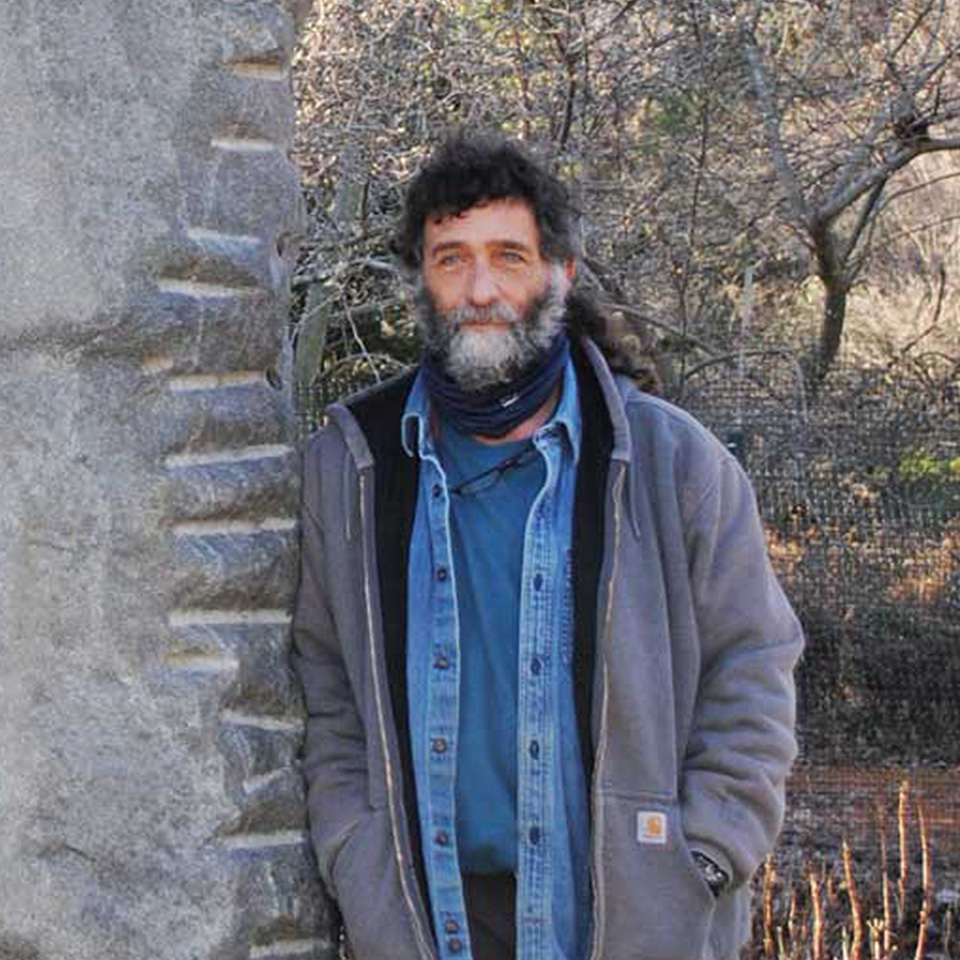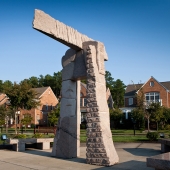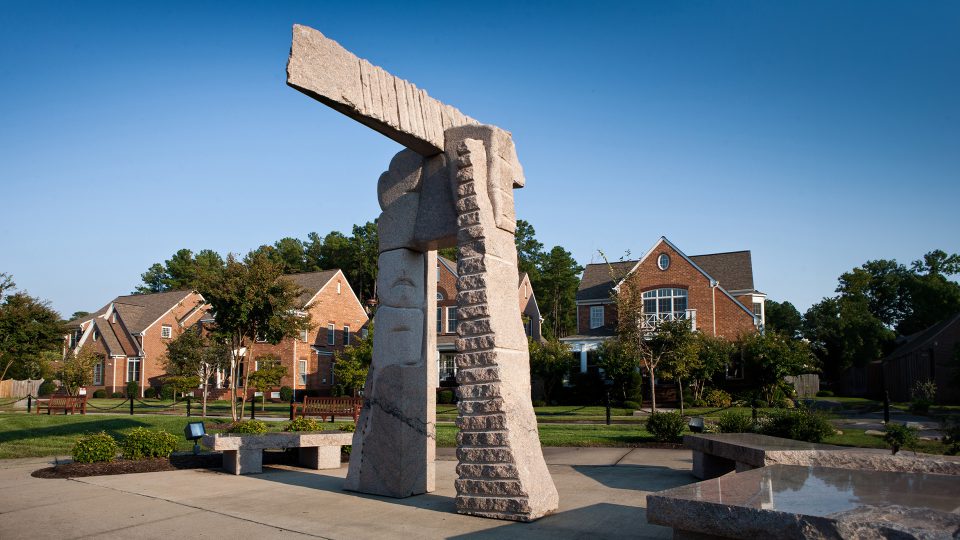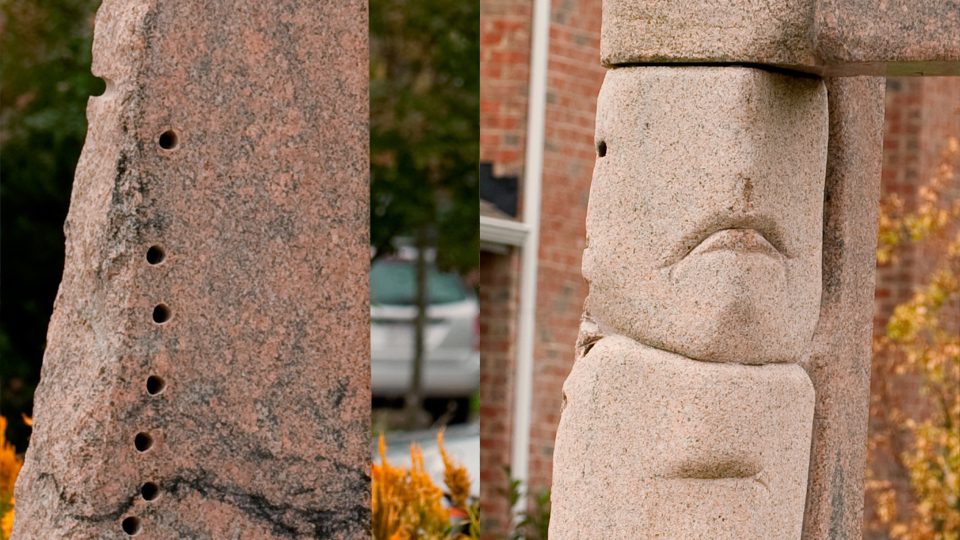Lenape Gate
HARRY GORDON
This massive work is typical of Harry Gordon’s work in several ways, beginning with the choice and handling of the material, in this case red granite. Gordon explains: “My work and the ideas behind it are tied very closely with the material it is constructed of — I have chosen traditional, ancient mediums with which to express myself. I try not to manipulate my materials beyond their natural state, but imbue them with a sense of dignity and grandeur to release their spirit.”
Lenape Gate also evokes other Gordon works in its composition, with two posts topped by a third element, a kind of lintel. The sculptor suggests a way of looking at it: “When I incorporate several elements together to construct a sculpture, I am looking at the way they relate to each other, and ultimately how they work together as a whole. A tilt here and a cut there can change the attitude of the piece and gives each one its own personality.”
The Lenape are Native American peoples of the American Northeast.
ABOUT THE ARTIST
HARRY GORDON
Looking at the massive wood and stone works that Harry Gordon creates today, it’s not immediately apparent that his early training steeped him in sculpture’s traditional roots and their emphasis on the human figure. That is … until you look very closely. “I started my sculpture career studying with Boris Blai, a very classical, figurative beginning,” for Blai had trained in Rodin’s studio, Gordon explains. “Although my materials and forms have changed a great deal over the years, it is still possible to find remnants of the figure in my work,” including the many works that stand on two vertical elements (legs) and incorporate another element on top (the body or arms).
By the 1990’s Gordon was working extensively in granite, and much of that work, like Newport News’ Lenape Gate, incorporates figurative or post-and-lintel elements. These ancient forms are rendered in materials that are only minimally worked, to preserve the innate qualities and dignity of their shape, texture and mass.
Gordon’s work is in the collection of museums, art centers, sculpture parks, universities, schools, municipalities and private collectors across the nation, and he maintains a busy schedule of exhibitions in galleries and art and sculpture shows.
Gordon’s involvement with sculpture takes many forms. In addition to being a working sculptor, he is a teacher of sculpture, a curator of sculpture exhibitions and collections, and a specialist in sculpture transportation and installation. (He has installed most of the sculpture in the collection of the Newport News Public Art Foundation). He earned a Master of Fine Arts from Rutgers University and a Bachelor of Fine Arts from Syracuse University, both in sculpture. Today, he lives and works in Lambertville, New Jersey.
Gordon’s website: gordonsculpture.com

Artist: Harry Gordon
Details: Red granite, 12′ high. Made in New Jersey. Installed 2004.
Site: Emily Dickinson Square, Port Warwick
Audio Tour
Hear artist Harry Gordon tell you about the piece.

My name is Harry H. Gordon. I created the sculpture called Lenape Gate, which is located at Emily Dickinson Square. The piece is made out of red granite. I do not like to use material that is quarried specifically for the sculpture, so this is made out of what would be scrap granite. I go to the quarry or to shops and find cutoffs. If you look at the two vertical pieces of the sculpture, you will see that there is a vein of stone that runs from one to the other, and yet the piece in the middle is missing. My assumption is that industry wanted the piece that was in the middle, and they threw away the rest, which for me were some very nice shapes.
The way I work is I find stone or wood that I can take back to my studio and look at. I like to use predominantly the same material for each sculpture, so I don’t like to mix different colors, and in this case with this sculpture, I was presented with these four very nice stones, and I started playing with them, moving them around, positioning them, and when I decide that there’s a way that I can put them together that I like, that is how I build the sculpture. I then go ahead, once I’ve made up my mind how I want it to look, and make notches and joints and build the sculpture. Then I’ll look at it, and as with this sculpture, I’ll go back in and carve details and reshape elements after it is assembled to create the whole piece.
This sculpture also has some musical qualities. If you cup your hand and tap over some of the holes in the sculpture, you will note that the stone rings.


